Personal Destiny

In Disney’s live-action feature Mulan, the eponymous hero (portrayed by Yifei Liu) disguises herself as a man and joins the Chinese army in order to spare her father from having to return to war. Through the trials that follow, she unlocks her hidden potential and embraces her true identity.
The movie found director Niki Caro partnering with cinematographer Mandy Walker, ASC, ACS. When Panavision spoke with Walker in late August, she was in Queensland, Australia, in the midst of preproduction for her next feature project, director Baz Luhrmann’s Elvis Presley biopic, which had seen its shooting schedule pushed back when productions worldwide shut down earlier this year due to COVID-19 lockdowns. The pandemic also prompted Disney to change course on Mulan’s release strategy. Originally slated for theatrical distribution back in March, the feature instead premiered exclusively on the Disney+ streaming platform on September 4. “People have been waiting for this movie, and we’ve been desperate for them to see it,” Walker says. “I’m really proud of it.”

Panavision: Had you and Niki Caro known each other prior to your meeting for Mulan?
Mandy Walker, ASC, ACS: No, and it’s funny because she’s from New Zealand and I’m from Australia, so we had worked with people who knew both of us, but we had never met before. I’ve always been a huge fan; Whale Rider was the first film of hers that I’d seen, and I always really wanted to work with her. I had the opportunity to interview with her for this movie, we got on really well, and it went from there. She’s amazing. She’s so organized, and smart, and a kind person, and the crew and the actors just loved her. It was a dream.
Was Disney’s animated Mulan a reference for you, or did you find other inroads to the movie’s visuals?
Walker: The story has been around for hundreds of years. It was originally a poem called “The Ballad of Mulan,” and other movies have been made about the story in China, and then there was the Disney animation. We looked at a lot of the previous incarnations of it, but this script was its own entity. It’s a new take on the story. One of the big influences for me was something that Niki said in one of our first meetings: ‘Just remember, Mulan is the center of the film, and I want the audience to be on her journey with her totally, through the whole movie.’ I just kept thinking of that.
We looked at contemporary Chinese cinema, the films of Zhang Yimou, things like Crouching Tiger, Hidden Dragon, and also Chinese art and architecture. A lot of the Zhang Yimou films put people in the center of the frame, and when you look at China’s architecture, it’s very symmetrical. It lends itself to putting things in the center. Normally if you’re shooting widescreen, you’ll place the actors on the frame’s thirds, but we decided to keep Mulan centered in the frame.
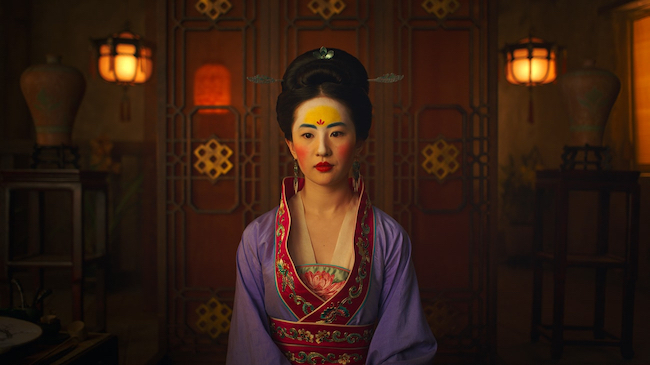
The movie is a portrait of a young woman discovering her identity, but it's set against a sweeping backdrop of a nation at war. Keeping Mulan in the center of the frame would have been part of this, but how else did you and Niki Caro seek to balance those two ideas?
Walker: Niki and I talked extensively about the battle sequences. We looked at a lot of martial-arts films and even how different battle sequences had been done in Game of Thrones and Gladiator. One of the things Niki and I discussed was to not have just a melee of violence or a mishmash of people fighting, but to instead keep the whole battle centered on Mulan. When she goes out to the main battle sequence, she’s wearing red, which is very important in Chinese culture. And we went to a place that was devoid of color — a harsh, uninviting, scary place, with geothermal steam rising out of the ground — and the opposing army wore mainly black and browns, so she would pop in this red outfit and be really visible to the audience at all times.
She's ultimately an elite warrior, so for special moments in battle, we had a lens that [Panavision senior vice president of optical engineering] Dan Sasaki made, based on a Gauss lens, with a little bit of magic in there and a little bit of chromatic aberration on the sides of the frame. And then Dan brought out his 2,800mm lens, which I used a lot for our battle sequences. Yifei did a lot of her stunts herself - the martial-arts moves, the sword fighting, the horse riding - so we could focus on her with really long lenses and be on her face. That was a big part of our visual language that we worked on: How do we keep the audience with her through all these sequences so they'll understand what's going on around her but still feel like they're emotionally with her throughout this whole story?
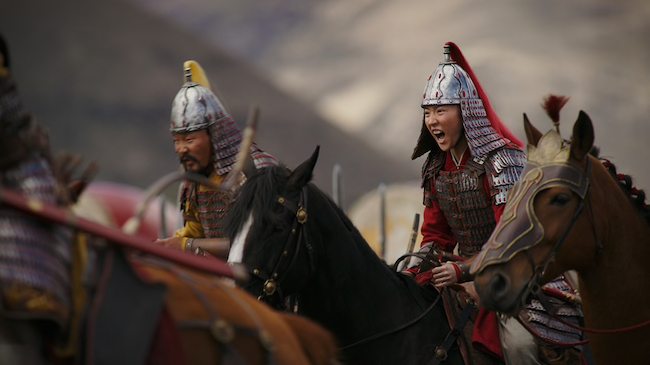
What were your primary lenses for Mulan?
Walker: Our main set of lenses were Sphero 65s that Dan had adjusted. There was one particular painting I showed him of a landscape, and I said, ‘That’s what I want our landscapes to look like.’ What he did was he lessened the contrast and color saturation a little bit, and then, on most of our lenses, we had a slight vignette with a focus drop-off, and some of them a vignette of exposure drop-off. I really like that; I think it feels like a portrait, it feels a little bit more painterly. We ended up keeping a lot of it in the mid-range or very long lenses. Occasionally we went super-wide, which would have been the 24mm, but that was rare, just for certain shots when we wanted to show wide vistas.
I talked to Dan very early on in preproduction. He's an amazing technician, but he's also an artist. What he does is very special. We'll sit and talk about the visual language of the movie in an abstract sense, how you can affect people emotionally with the lensing, depth of field, aberrations, color and contrast. We talk more like we're designing a painting.
For a start, Dan developed an 85mm Petzval lens, which only focuses on the center and drops off toward the edges with an elegant distortion that pushes everything into the background and focuses your eye right in the middle of the frame. It's a portrait lens. We used it for all of Mulan's close-ups - that was her lens. He also integrated the Spheros to work with the Petzval and the Gauss lenses, balancing out the color and the contrast so that they would work together. And the same with the 2,800mm; he adjusted it to match what we'd done with the other lenses.
I also work with [Panavision marketing executive] Lori Killam at Woodland Hills, who is amazing. She gets involved with me in the story; it's become an integral part of the way I work. Before I left for Auckland, I went to Woodland Hills twice and tested everything. After we'd chosen the lenses, I went to New Zealand and my AC Brenden Holster went to L.A. to prep the package, and then Panavision Auckland serviced the production.
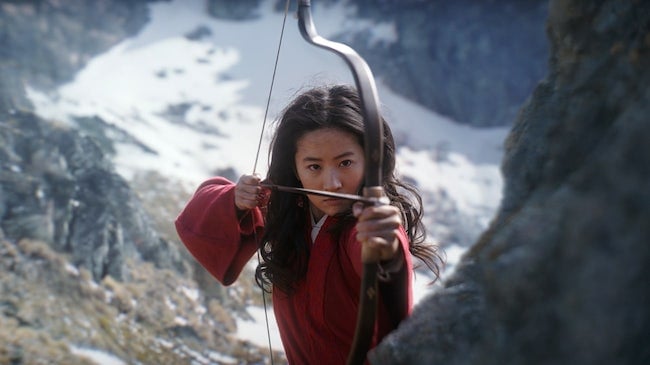
Did you know from the very beginning that you wanted to shoot digitally in the 65mm format?
Walker: As soon as we started talking about storytelling I did. It made me think of films like Lawrence of Arabia, where they perfectly used the scale of the epic landscape and the intimacy of the characters. I feel like 65 is perfect for this type of filmmaking. You can separate people from the background on a 50mm lens on a wide shot, top to toe, which is beautiful, but you can also be intimate with someone and let the background just drop off. And then if I really wanted more depth of field, I would give us more light. That was a main reason I shot 65mm, was to be able to control the depth of field outside in a wide shot and focus more on Mulan.
Were you also using any zooms?
Walker: We had [modified and expanded] 11:1 and 3:1 zooms, and I had a couple of long primes, such as an 800mm. When we were doing our battle sequences, we could focus on Mulan’s face through all the soldiers. We had three to five cameras going all the time when we were on the South Island doing our battle sequences. Our main camera would always be close to the actors, and a couple of them would be on these super-long lenses grabbing moments of Mulan in the battle, which worked quite beautifully.
By the end, the crew were fighting over who was going to have the 2,800mm. It was a challenge, and once they got used to it, they were loving it. With that lens, I could have a sequence where we see the shadow warriors coming towards us on their horses, and I could carry them for 300 feet without them suddenly coming up to the camera. I could get that really long moment where they’re not changing size very much. If you’re on a wider lens and they start coming towards you, then boom, they’re gone.
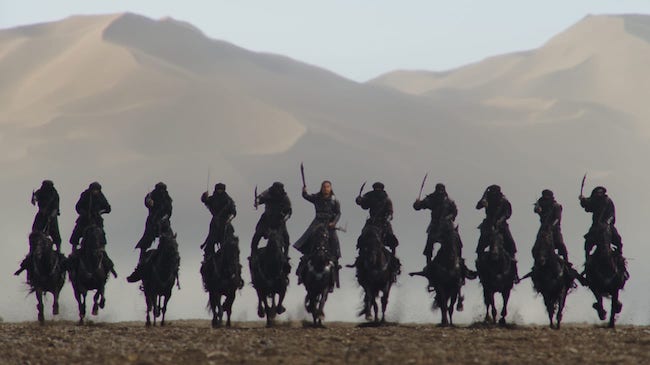
One of the camera operators, Ian McCarroll, particularly loved doing this, so we'd get him in a golf cart with the 2,800mm and the 800mm. He'd be sent up to the next mountain, and he would get this incredible stuff back to us. I love my crew getting excited about what they're doing, so I always try and engage them in the visual language and in understanding what we're doing so they can contribute creatively, too, rather than just telling them what to do.
Would you also use multiple cameras in the more intimate dialogue scenes?
Walker: Ninety-nine percent of the time we had two cameras going. I’m very used to doing that now. I like working multi-cam because I think you can always find a shot for the other cameras, and it adds to the options for the director.
Was there a T-stop you tried to maintain, or were you adjusting the stop depending on the depth of field you wanted for a particular shot?
Walker: Most of our lenses would perform the best around at least T2.8/4. So even though we had faster lenses than that, I rarely shot them wide open. The other thing is, I always tried to light to at least 5.6 in case Niki would say, ‘Can we do this slow motion?’ And then we’d ND down to shoot at 2.8/4. We had an LF that could go 150 frames, and I’d always be prepared for that. And the zooms I shot at about 8 to have enough depth of field and clarity, because a lot of the time I used them as a long lens. And the 2,800mm only had three stops — T16, 22 and 32 — and we were always at least at 22! [Laughs.]
You were working with production designer Grant Major, who's collaborated with Niki Caro on a number of projects. How was your experience fitting into that creative relationship?
Walker: Niki is a smart collaborator and gets the right people around her who are going to bring something to the movie and work well together. In addition to Grant, costume designer Bina Daigeler and makeup designer Denise Kum came on, too. Niki had worked with all of them before. They’re people like Niki; they’re very collaborative and smart. We worked seamlessly together on this film.
We all studied the architecture, environments, clothes and other artifacts of the era. But this is also a Disney movie, and we didn't want to make it look like it was a documentary. So the elements were true to the period but enhanced. Grant would build as much set as he could so that any greenscreen sections were minimal and we could capture as much as possible in camera. I think it helps the feeling of the movie, and it was something that Niki wanted to do right from the beginning. You feel more connected when it feels more real. In the battle sequences, too, we had all the soldiers there, we had all the horses there, and we were in those environments.
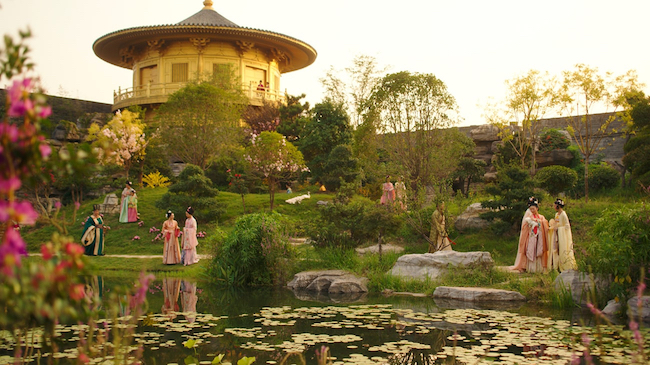
The film is also about Mulan’s devotion to her family. The reason she goes into the army is to protect her father, who has an old war injury; they feared that if he were to go into battle again, he wouldn’t come back, so she goes in his place. When we’re in her home, we wanted to emphasize the fact that she had a beautiful, warm family environment. We were very conscious of not making it too antique-looking, I suppose, and giving it vibrance and emotion. Their village is colorful and warm and homey, and it's the same in her house — there’s diffuse, warm light coming in all the time. It’s a place where you feel their close relationship and love.
Which makes her decision to go into war that much more of a sacrifice.
Walker: Exactly. And you see her going into these scary environments immediately. As soon as she leaves her home to travel to the training camp, you realize that she’s out in a world that has nothing to do with where she came from.
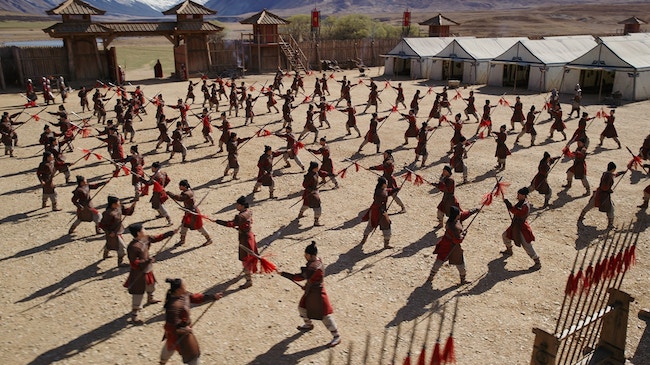
You made a look bible for the movie — is that something you do for every feature?
Walker: It depends on the director I’m working with. On Mulan, we did some previs for some of the more difficult battle and stunt sequences, and we had some storyboards for some sequences where we had to be prepared for the logistics of how we were going to cover things. My daughter was working with me, and she made a program so that every day we had the script pages, the reference material, previs frames, art-department concept designs, my location pictures, notes — everything in one document. And then we would add DIT stills, and we took photographs of every lighting setup, and the lighting department wrote down all the lamp settings from the dimmer board. I could hand that over to second unit or I could go back and have all that information when we did additional photography. It’s a great way to communicate and log information in one place.
How long was principal photography?
Walker: Main unit had a 74-day schedule. Not very long for a film of this size. We did continuous 10-hour days, and we finished on the day that we said we were going to finish. We didn’t go over schedule by one day, and I think we only did overtime a few times on the whole film. We would start at 7 and finish at 5, and then I could watch dailies, plan for the next day and have dinner, and other crew members could go home and see their kids and have a normal life. It was very civilized.
This was the first time on a movie of this scale that there was a female director, female DP, female 1st AD [Liz Tan], and Niki said to us all, 'We're going to do this, and we're going to do it really well.' So we were incredibly organized and together in our planning and our execution. And Niki's also very quick; she knows when she's got it, and she moves on. We wouldn't have achieved what we did unless that happened.
To help move things along, gaffer Shaun Conway and I lit the stages in 360 degrees. All the lights were on a dimmer board for color and intensity, and some would be able to drop down from the ceiling to become a key and then slide back up. So in the throne room, which was a 300-foot set, I could turn around from looking one way through the whole set to the other way in the same time it took us to move the camera. I planned every set like that, the smaller sets, too, so I could light while moving the camera and be ready really fast. That was my preproduction: figuring out how to achieve things quickly so Niki could have that time and not be waiting for me, as well as how to have a set that gave space to the actors, without lights being brought in on the floor all the time. One of the first things I said to my crew was, ‘This is our mission on this film: We don’t want production to be waiting for us, but we want it to look amazing.’ I’m really proud of what we did, and I think we did it well. We would always be doing 30-50 setups per day — and again, having two or three cameras on set helps with that as well.
There must be a lot of pride in being a part of that team, but there could also be great frustration that it’s taken so long for there to be a film of this scale spearheaded by so many women heads of department.
Walker: I’m just proud. I don’t ever see it as an obstacle. I know people sometimes didn’t give me a job because I was a woman, and they wouldn’t consider me because it’s traditionally a man’s job, unconscious bias, whatever it was. But it’s getting better. That it’s taken us longer to be in this situation can be frustrating, but I look at it really positively and think, ‘Now we’ve done that and opened the doors for other women to come in and be trusted to do the same thing.’ I have to say, Disney were amazing in their support for us. We’d all worked on a lot of projects before, but this was the first time that we were together like that, also with the female lead, and the costume designer, and makeup — it was a lot of women heads of department. Yeah, it’s time.
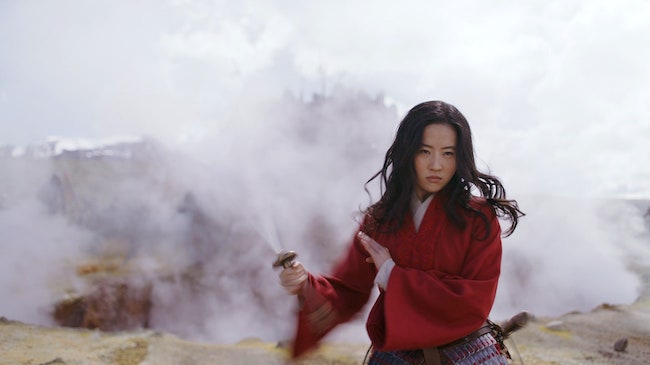
Creatively, what was the most rewarding aspect of shooting Mulan?
Walker: The most exciting and challenging for me was doing the battle sequences, prepping for them, and finding the right locations and the right way to approach them. I’m really happy with what we did. I found it exciting. I love doing new things, having those challenges put to me on a movie, and having those opportunities to be creative and efficient while keeping it beautiful and emotional. That was my mission.
Working with Niki and Yifei was really special and very rewarding because they're both incredible, talented women who are the best at what they do. When they cast Yifei, she was on another project, so we all waited for her to come back. Kudos to them for doing that, because she's incredible. Niki and I would sit at the monitor and watch Yifei, and there would be moments like when she decides that she's going to put the armor on and leave her house; she gets the sword and swings it and points it at the camera, and somehow she found the reflection of her eyes in the sword, straight to the lens. Niki and I looked at each other and got shivers all up our spines. That to me is what makes our job so rewarding and special, is to work with people who are so uniquely talented.
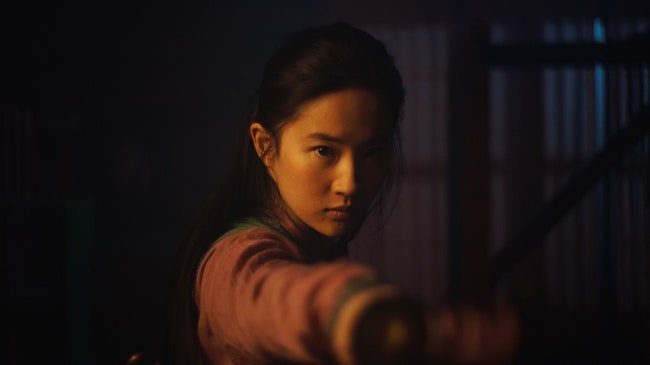
Mulan images courtesy of Disney. Mandy Walker, ASC, ACS photo courtesy of the cinematographer.